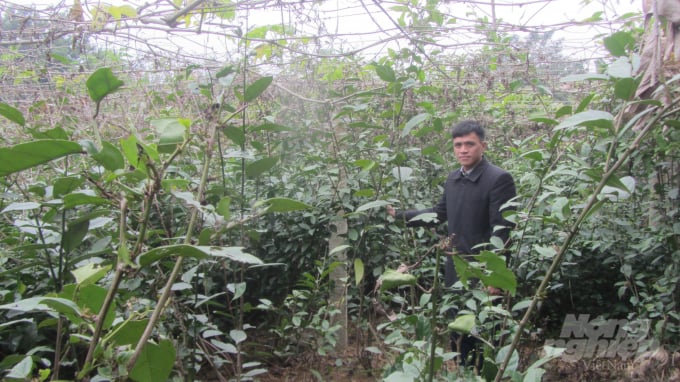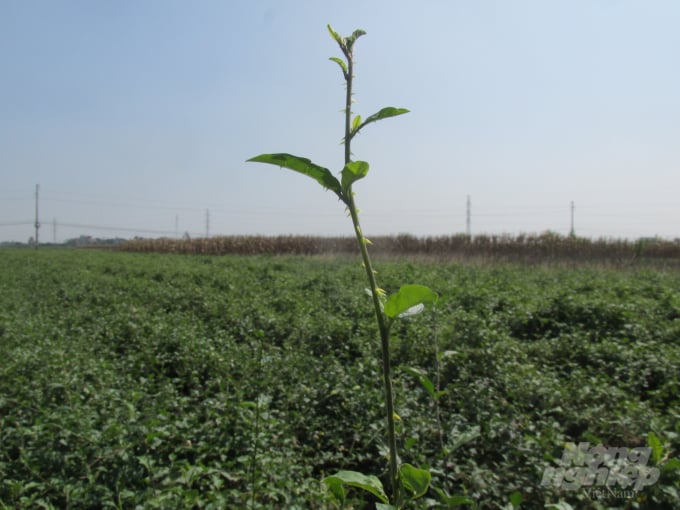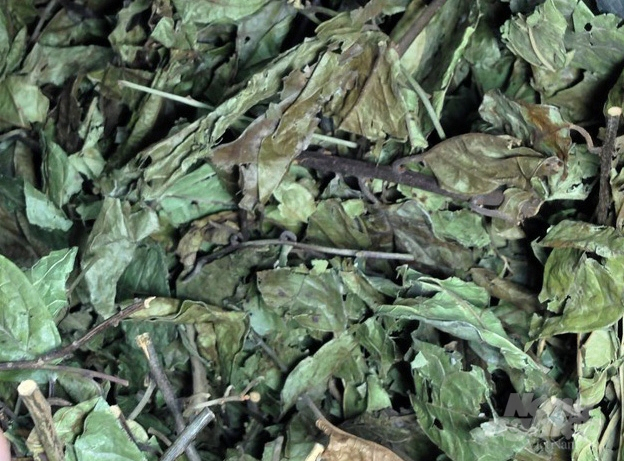May 31, 2025 | 23:51 GMT +7
May 31, 2025 | 23:51 GMT +7
Hotline: 0913.378.918
May 31, 2025 | 23:51 GMT +7
Hotline: 0913.378.918
Cu Yen Commune is regarded as one of the cradles of rare medicinal herbs in the northern mountainous provinces. However, for a long time, ethnic people here have had to prioritize the cultivation of corn and rice to alleviate hunger and reduce poverty, so many rare indigenous medicinal herbs such as black sage are in danger of disappearing.

The Celastrus Hindsii garden of farmer Bui Hong Thuy. Photo: H. Tien.
To gradually recover the lost medicinal herb areas, the communal People's Committee has assigned Hoa Binh Agricultural and Medicinal Plants Development Co-operative in coordination with the Luong Son District’s Economic Department to set up associated models of planting and consuming medicinal herbs produced in the area.
Initially, the cooperative has established a group specializing in planting medicinal herbs, consisting of 9 members, About 3.5 hectares of medicinal plants of all kinds have been grown, including 2ha of Celastrus Hindsii, 1ha of Solanum Procumbens, and 0.5 ha of Panax Pseudo Ginseng and some others such as Radix Fallopiae Multiflorae, Medicinal Indian Mulberry, Millettia Speciosa Champ and Black Ginger. These medicinal herbs are grown on highlands and hills or intercropped under forest trees or in perennial fruit trees.

The model of planting Solanum Procumbens in Cu Yen Commune. Photo. H.Tien.
Mr. Bui Hong Thuy, Director of Hoa Binh Agricultural and Medicinal Plants Development Cooperative revealed: “My family has grown 0.4ha of Celastrus Hindsii since the beginning of 2020. Currently, we are going to enter the first harvest. Dried products can be sold to traders at a price of between VND15,000 - 30,000/kg, depending on the time of harvest.
The Celastrus Hindsii plant grown here gives very high medicinal contents due to the suitable soil and climate thus it is often easier to sell than products of the same type but grown in other localities. The cooperative plans to expand the cultivation areas, mainly cycads, and thorns, in all the hills and residential gardens in the commune. However, the Covid-19 pandemic and the low rainy weather have slowed down the cooperative’s planting process.
With seedlings support from the district’s economic office, Ms. Nguyen Thi Duyen (a member of the cooperative) has also grown 0.3ha of Celastrus Hindsii, Solanum Procumbens, and some other local medicinal herbs.
According to Ms. Duyen, processing and consuming are among the hardest parts of growing and trading medicinal plants. Currently, it now just basically stops at preliminary processing (cleaning, drying) then selling to traders. However, the products have to compete fiercely with those imported from China, so the efficiency is very low. The production of medicinal plants is actually not commensurate with the local advantages.
"The quality of Chinese medicinal herbs is unknown, but its price is much cheaper than similar products produced locally," Ms. Duyen said.

The dried Celastrus Hindsii of Hoa Binh Agricultural and Medicinal Plants Development Cooperative. Photo: TL.
Researches from the reality show that Celastrus Hindsii is a shrub that originated from tropical forests so it is best to plant under the canopy of large productive timber forests. Seedlings can be sown naturally or grown by cuttings in a bag.
The suitable time for growing medicinal herbs in general, and Celastrus Hindsii in particular is from the aftermath of the spring season (February-April). Hilly red soil or soil in the home garden are the most suitable for planting as it ensures fast drainage.
In the first cultivation year, farmers should add NPK in addition to rotten organic fertilizers to help the plants grow healthy and have more roots so that they can absorb nutrients from the soil. In the following years, only microbial organic fertilizers are applied in combination with rotting manure to increase the quality of the herbs. Pests and diseases, mainly leaf-eating pests, only arise mainly in the winter.
After 18-24 months, the plants will be for business exploitation which can last for 15-20 years. Harvest can take place every 6 months. Trunks, branches, and old leaves are parts of the plant that can be harvested by cutting with a saw or scissors at 30-40cm from the roots but leaving new sprouts from the trunk for the next crop.
The harvested parts should be separated with branches cut short 2-3cm and let dry, leaves also dried until crispy and sold to traders or oriental medicine pharmacies. Dry products can be stored in vacuum-sealed plastic bags for later sale.
Translated by Van Trang

(VAN) Several scientists and farmers are experimenting with soil treatment in some key durian-growing regions such as Cai Lay (Tien Giang), Dak Song, Gia Nghia, and Dak R’lap (Dak Nong).
/2025/05/25/4127-3-073637_820.jpg)
(VAN) Thanks to the promotion from an FAO-implemented project, vegetable production in greenhouses in Moc Chau has seen strong development, from 1.5 hectares in 2021 to nearly 50 hectares in 2024.

(VAN) FAO has recently supported USD 140,000 to implement the project 'Risk mitigation human-animal interface risks through disease control initiatives in pig farming.'

(VAN) The People's Committee of Tra Vinh province has approved an adjustment to the investment policy for the Green Hydrogen Plant project, increasing its area to approximately 52.76 hectares.
![Reducing emissions from rice fields: [2] Farmers’ commitment to the soil](https://t.ex-cdn.com/nongnghiepmoitruong.vn/608w/files/news/2025/05/05/dsc08881jpg-nongnghiep-140632.jpg)
(VAN) Clean rice cultivation model in Thuong Tan commune, Bac Tan Uyen district, is assisting local residents in achieving sustainable agriculture by substantially reducing costs, increasing productivity, and protecting the environment.

(VAN) At the conference to disseminate Resolution No. 68, AgriS introduced its digital agricultural ecosystem and reaffirmed its commitment to accompanying the Government in promoting private sector development and sustainable agriculture.

(VAN) 'Blue Ocean - Blue Foods' initiative is designed to restore marine ecosystems and establish sustainable livelihoods for local communities by cultivating a minimum of 1,000 hectares of cottonii seaweed in the first three years.